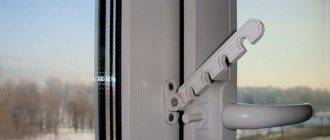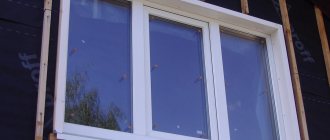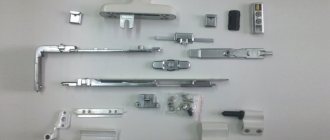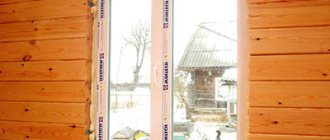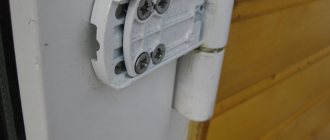Modern plastic windows have many advantages over Soviet-made wooden windows, including effective noise protection, tightness, and reduced heat loss. But there are also disadvantages - the lack of micro-ventilation creates a lack of air in the room and contributes to the accumulation of moisture and the creation of a greenhouse effect. Any room must be ventilated not only during the warm season, but especially when the heating devices are on.
It is advisable to ensure a flow of fresh air not only in residential but also in public spaces. Since its deficiency has a bad effect on people’s health and performance. This drawback can be eliminated by opening the top for ventilation. If the window sash has only a rotary opening, then a comb can be installed to ensure ventilation. It can be installed on any plastic windows, regardless of the profile.
What is a comb for a plastic window
A crocodile or comb is the name given to a special device that limits the opening of a window sash. It is not included in the standard package of windows; it can be ordered during installation or purchased and installed on ready-made windows. The comb is best suited for non-hinged windows and is a simple device consisting of a toothed strip and a retaining sleeve. It will be indispensable for ventilation in windows that do not have top opening.
The teeth fix the opening of the sash with a gap of 5 to 80 mm, depending on the type of comb. In this case, the sash will not close from a draft or gust of wind. Also, this design will help prevent the sash from being suddenly torn off, which is very important for lovers of indoor flowers and pets.
Kinds
All types of combs are very similar in design and consist of two elements - a retainer and a serrated plate. The gap between the holes ranges from 1 to 7 cm depending on the manufacturer. Crocodiles come in plastic, metal and combination types.
They differ from each other in the following parameters:
- Material (metal or plastic).
- Color.
- Method of fastening to window frames.
Depending on the type of attachment to window sashes, there are two types:
- Installed under the handle.
- Mounted in the overlap (end of the sash).
The last type of fastening does not depend on the location of the handle. This may be an alternative option when the installation of the comb is interfered with by the pressing mechanism of the adjacent sash.
The length of the comb depends on the number of holes, with 4 holes the length is 10 cm, with 5 notches - 13 cm. There are models for installation on balcony doors.
Peculiarities
A window stop is a design that allows you to open a window slightly, leaving a small gap and fixing the window sash in a given position. The device received the name “comb” for its external resemblance to a comb. It has several grooves. A rod can be placed in any of them, which allows you to hold the slightly open window in one position, and prevent household members and pets from getting too close to the window opening.
The comb is installed on turning windows, that is, on those where the sash opens exclusively in the horizontal direction. In essence, the limiter allows, if necessary, to open the sash like a window. However, nothing prevents you from installing a comb on windows with a tilt-and-turn mechanism. Its use will reduce the gap formed when the sash opens in the vertical direction.
The design consists of a strip with slots and a window sash position lock (rod). The strip is mounted to the frame, the clamp is installed in the window sash. By installing the latch in one or another groove, it is possible to open the window within 1-10 cm. The opening angle depends on the length of the strip with grooves and the number of them.
The more grooves the strip has, the more precise adjustment of the sash position can be achieved. The standard plank is 10-12 cm in size with 4 grooves.
Manufacturers of limiters usually indicate 2 main functions of the comb:
- ventilation of the room (especially important for windows that do not have supply valves, sashes that open exclusively horizontally);
- protection of the glass unit from damage due to sudden slamming of the sash due to a draft or strong wind.
Ensuring the safety of children and pets is another advantage of the limiter.
By adjusting the position of the comb, the user has the opportunity to open the sash wider or narrower. Thanks to this, it is possible to achieve an optimal microclimate in the room, prevent the formation of condensation on the plastic double-glazed window, without overcooling the room.
You can leave the window in this position even for the whole day (which is especially important in the warm season). By opening the window literally 5-15 cm and using a limiter, you will ensure optimal air circulation in the room. However, it is important to understand that the comb only fixes the window, but in no case is a locking device. Residents of the first floors should not leave their windows open and secured with limiters when leaving the house.
In addition to the obvious advantages, the design also has disadvantages, which are best learned about before purchasing and installing the comb. Installation of the device requires the presence of additional perforations in the profile, which slightly reduces the thermal insulation properties of the glass unit. The sound insulation coefficient is also reduced by 2-3 dB. Finally, the presence of holes leads to a decrease in the strength of the profile and possible violations of the geometry.
If we compare supply valves with limiters, then the latter, of course, are inferior to them in terms of safety and functionality. The operation of double-glazed windows with valves is more convenient, but such products are more expensive.
The limiting elements may differ in the number of grooves. Standard models have 4 slots, but there are also options with 5 slots. In addition, there are several types of combs.
Outdoor
Designed for folding window sashes (for example, vents). It has 3-4 grooves, fixes the sash while ventilating the room.
Built-in
Invisible to the eye analogue of the external comb. In terms of its functioning and number of grooves, this option is identical to the one described above. The difference is the greater aesthetics of the window, since the built-in limiter is invisible.
Constant brake
Perhaps such a name will seem unknown to many, although, perhaps, everyone has come across such mechanisms for sashes. A permanent brake is usually installed on the doors of shops and offices. All a person needs to do is pull the door towards him and open it. No need to close. Thanks to the built-in mechanism, the door will slam shut automatically.
A similar system is mounted on a window, preventing the sash from spontaneously closing or swinging open excessively. Such a mechanism should not be pulled by force when trying to cover the window, as it may break.
Cable limiter
Structurally, it consists of 2 elements, one of which is fixed on the frame, and the second on the profile. They are connected to each other by a metal-based cable (sometimes in a plastic braid). There are models where the cable is replaced with a thin chain. The micro-ventilation function is realized thanks to the short (up to 20 cm) length of the cable.
Unlike a standard comb, it does not allow you to fix the sash, but only holds it , preventing further swinging of the window. At the same time, the cable stop is stronger than the comb and can withstand a breaking force of up to 550 kg (depending on the model).
For protection against children and unauthorized entry from the outside, a cable stopper is more suitable than a comb. For ventilation it is better to choose the latter.
When installed on swing sashes, the limiter can be mounted anywhere in the profile and frame; when mounted on tilt-and-turn structures, only in the upper part.
Related article: How to attach a mosquito net to a plastic window
Handle-lock
This is the most effective limiter that provides protection against children opening the window. It is a metal handle with shut-off valves. There is a lock on its outer part. Opening is done with a key.
Using the key, you can securely close the sash or give it a folding position. In appearance, such designs are indistinguishable from ordinary handles. The inconvenience is the need to keep the key safe. To do this, find a place inaccessible to children. The use of a key also includes overhead and mortise locks installed on a double-glazed window, as well as a stopper and blockers for sliding windows.
Depending on the material used, there are also several types of combs.
Plastic
This is the most accessible type. It can have several color finishes and goes well with PVC structures. The base is ABS (impact-resistant) plastic. The standard number of grooves is 3-4.
The disadvantages include the lowest strength indicator and, accordingly, a shorter service life. It is not recommended to install such products on windows facing the windy side, since under heavy loads they can become deformed and burst.
Advantages and disadvantages
Combs made of different materials are installed in the same way and have the same operating principle. Their main task is to prevent the window from slamming shut in drafts or strong winds.
The main advantages of plastic models:
- Easy to install.
- They have a large selection of colors.
- They are very inexpensive.
Cons: plastic is not very durable. It can be accidentally broken.
The main advantages of a metal comb:
- Easy to install.
- Durable base, resistant to various loads.
Flaws:
- Limited color range.
- High cost compared to the plastic model.
Metal combs are also produced without painting, so such fittings may look bad against the background of a plastic profile. Its price is much higher, but with long-term use it justifies itself. They also produce combined models; they are more expensive than plastic ones, but much stronger. In them, the main body with holes is made of plastic, and the retainer is made of steel.
The main advantage of all types of combs is a fixed gap with a width of 5 to 80 mm for ventilation of the room.
Main disadvantages:
- The air flow is distributed vertically and horizontally, which can lead to drafts.
- With the most minimal opening, a gap is formed, leading to rapid cooling, so you should not open the doors for ventilation all night in the cold season.
- The comb is not a lock, it only secures the doors. Therefore, if the window is located on the lower floors, it may be accessible to intruders.
Choosing a different ventilation option
It is worth saying that a comb for PVC windows is just one of many ways to increase their functionality. In campaigns selling such products and providing installation services, the client can choose another option he likes, which will be more technologically advanced. The most common is multi-stage micro-ventilation, which ensures normal air exchange in the apartment when the windows are closed. Many companies include this type of ventilation as part of the basic package of plastic window systems. When the handle is turned up 45 degrees, the window is depressurized and the system switches to micro-slot ventilation mode. From this moment, through a small gap formed as a result of the sash moving away from the frame, a weak air flow from the street begins to enter the room.
Comb option for PVC windows
With this method of ventilation, the room does not get too cold, there are no drafts, and excess moisture and dust do not penetrate inside, because the resulting gap is negligible. But at the same time, it allows you to achieve the proper level of fresh air in the room that is optimal for human life.
How to install
When replacing old windows with plastic ones, you can order the installation of a limiter. If the windows are already in place, then you can install it yourself.
There are two types of fastening: to the end side of the window frame (flush) or under the handle that opens the sash. In both versions, the latch is installed on the movable sash, and the plate with holes is installed on the fixed one.
The simplest and most affordable option is installation under the handle; this does not require special skills. If this option is not suitable, then you should contact qualified specialists to install the float limiter. Since incorrect installation can lead to deterioration of the tightness, sound insulation and thermal insulation of the profile.
Procedure
First, you need to secure the clamp under the window handle, and then attach the comb strip itself to the frame using self-tapping screws. You need to carry out all the actions slowly, thinking about every movement, since it is impossible to reinstall the mechanism in another place.
More details about the installation procedure
First, the window handle is disassembled. For this purpose, the decorative cover that covers the base of the handle is carefully pryed off with the tip of a knife.
Comb on a closed window
Tip: When removing the decorative cover, you need to act carefully. The plastic it is made from is easy to scratch. This will not change its functionality, but its appearance will become unsightly.
Under the cover are hidden screws that secure the handle. They must be unscrewed to remove the handle. Using the pin she has, the window lock opens and closes. The bracket together with the metal frame is placed in place of the handle in such a way as to align all the holes. When the adjusting pin is inserted into a special hole, the bracket bar will “sit” on it. Then the handle is installed in its place and screwed. The tip of the rod should protrude from the outside of the sash.
Step-by-step instruction
To install the limiter you will need:
- First remove the handle. It consists of two parts - a strip adjacent to the sash and the handle itself. The plank is divided into upper and lower parts. You need to lift and rotate the top bar; there are two screws on the bottom that need to be unscrewed with a Phillips screwdriver. After this, the handle is removed.
- Place the latch in place under the handle.
- Place the handle on the clamp and secure with screws.
- Place the comb on the clamp and mark under the fasteners with a marker or pencil. You should pay attention to ensure that the comb does not interfere with the opening and closing of the windows, since in the future it will be very difficult to reinstall it to the left or right. The holes for the screws must be positioned strictly vertically, otherwise the structure will not last long.
- Using a drill, drill the first hole; it should be up to 13 mm deep. The part is attached to a plastic window with self-tapping screws up to 13 mm long. This is done to preserve the reinforcement, which is not advisable to drill.
- Secure the comb using one self-tapping screw. Check that the second hole is correctly marked.
- Drill a second hole.
- Secure the part with a second screw.
Proper installation of the product guarantees a long service life and is within the power of any home craftsman.
Required tools for installation
To install the comb on plastic windows, you need to prepare:
- retainer;
- drill;
- drill or screwdriver;
- 2 screws;
- marker or pencil for marking;
- Phillips screwdriver or screwdriver;
- the comb itself with the pin.
Sometimes self-tapping screws are included with the limiter. But you can purchase others - no more than 13 cm long, so as not to scratch the reinforcing layer on the plastic profile.
It is advisable to buy an opening blocker in a store that specializes in the sale of goods for construction and repair.
